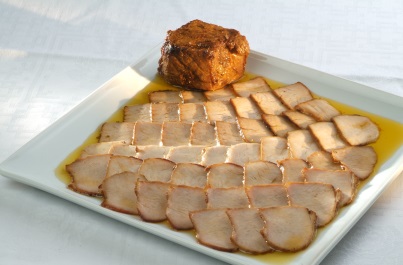Lomo de orza
Preserved Pork Loin
An orza is a large earthenware, jarlike container with a round opening at the top. Traditionally, it has been used to preserve foods in lard, especially pork after the yearly matanza, or "slaughtering". The advent of refrigeration has made orzas nearly obsolete, but the wonderful flavor of this dish will make you want to return to the past. You can use an earthenware crock or similar container in the absence of a classic orza. And don't be concerned about the large amount of lard, as the bulk of it is used only to prevent spoilage. Ask your butcher for high-quality pork lard for the best result.
- Serves 8
Ingredients
- 2 pounds lard
- 1 boneless iberico pork loin, about 2 pounds, cut into 1/2-inch thick slices
- Salt
- Freshly ground black pepper
- 15 cloves garlic, peeled but left whole
- 2 thyme sprigs
- 4 bay leaves
- 1 tablespoon fresh or dried oregano leaves
Preparation
In a large, deep skillet or saute pan, heat 3 tablespoons of the lard over high heat. Lay the pork slices in the pan, season with salt and pepper, and fry, turning once or twice, for about 2 minutes total, or until browned on both sides.
Add the remaining lard to the pan. When it melts, add the garlic, thyme, bay leaves, and oregano. The pork should be submerged in the lard. Decrease the heat to medium and cook the pork for 15 minutes, or until cooked through.
Remove the pan from the heat, let cool slightly, and transfer its contents to an earthenware crock. The meat must be fully covered by the lard, so arrange the slices as needed. Let stand until cool and the lard has solidified. Cover and store in a cool cellar or other cool area or in the refrigerator. The preserved pork will keep for up to several months.
To serve, remove as many pork slices as desired from the lard and heat them briefly, turning as needed, in a skillet over high heat. Serve hot.
You may be also interested in...
See also
 | Ibérico Grilling Pork Sampler: This quartet of delectable, juicy Ibérico de Bellota cuts of pork is made for the grill. Comprised of Spain’s finest free-range, acorn-fed pork, this combo is ideal for entertaining guests at a summer barbeque or for a Spanish-style family gathering on a lazy Sunday. |
Poultry, meat, and game recipes: Spanish cooks readily draw on a broad palette on poultry, meats and game for the everyday table, just as their ancestors have for centuries
Andalusia recipes: The Romans taught the Andalusians how to cultivate wheat and vines and used the fish from the seas to produce the best "garum" in the empire. The Arabs taught the Andalusians how to grow fruit and vegetables. They used irrigation systems and improved the cultivation of olive trees and the production of oil. Furthermore, the Greeks, Phoenicians, Carthaginians and Visigoths left their mark on the art, science, culture and gastronomy of Andalusia.






